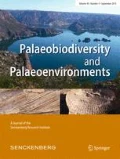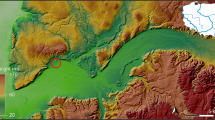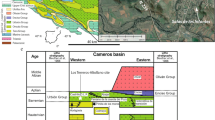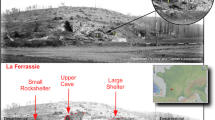Abstract
Nine terrestrial mammal localities of Miocene age based on body fossils have been reported from the island of Crete to date. A new locality where footprints of terrestrial mammals were exposed has recently been discovered in western Crete. Platýlakkos, the locality, is situated near the village Voúves, west of the city of Chaniá. The ichnofossils come from lacustrine deposits that belong to the Chátzi Formation. The most impressive finding is a clearly defined footprint that might be referred to a large-sized hyaenid. The footprint impression, a convex hyporelief on a sandstone slab, is a natural cast of a left manus where the traces of the interdigital pad and all four digital pads, as well as their respective claw marks- are clearly visible. Based on nearby marine deposits of the Chátzi Formation, the age of the fossiliferous layer with the footprints can be considered to be early to middle Turolian (MN11–MN12) in terms of mammalian biochronology. To date, there is no certain record of Miocene large-sized hyaenid footprints worldwide, and thus this isolated footprint might belong to a new ichnotaxon. However, in the absence of a trackway, the erection of a new ichnotaxon is avoided. The Platýlakkos findings are the first recorded case of fossil land mammal footprints from the Neogene of Crete, and Greece in general. They further the evidence for the presence of well-established terrestrial environments and faunas in the area of Crete during the Late Miocene.






Similar content being viewed by others
References
Abbassi N (2010) Vertebrate footprints from the Miocene Upper Red Formation, Shokorchi area, Zanjan Province, NW Iran. Ichnos 17:115–126
Anton M, López G, Santamaria R (2004) Carnivore trackways from the Miocene site of Salinas de Añana (Alava, Spain). Ichnos 11:371–384
Athanassiou A (2004) On a Deinotherium (Proboscidea) finding in the Neogene of Crete. Carnets Géol Noteb Geol Lett 5:1–7
Benda L, Hiltermann H, Kuss SE, Symeonidis NK (1970) Der erste Mastodon-Fund der Insel Kreta. Ann Géol Pays Hellén 21:167–177
Bonneau M, Ginsburg L (1974) Découverte de Dorcatherium puyhauberti Arambourg et Piveteau (Mammalia) dans les faciès continentaux de base de la molasse tertiaire de Crète (Grèce): Conséquences stratigraphiques et tectoniques. C R Soc Geol Fr 11-12
Bromley RG, Milàn J, Uchman A, Hansen KS (2009) Rheotactic Macaronichnus, and human and cattle trackways in Holocene beachrock, Greece: reconstruction of palaeoshoreline orientation. Ichnos 16:103–117
Cohen A, Lockley M, Halfpenny J, Michel AE (1991) Modern vertebrate track taphonomy at Lake Manyara, Tanzania. Palaios 6:371–389
Costeur L, Balme C, Legal S (2009) Early Oligocene mammal tracks from Southeastern France. Ichnos 16:257–267
de Bruijn H, Meulenkamp JE (1972) Late Miocene rodents from the Pandanassa Formation (Prov. Rethymnon), Crete, Greece. Proc Koninkl Nederl Akad Wetenschappen B 75(1):54–60
de Bruijn H, Zachariasse WJ (1979) The correlation of marine and continental biozones of Kastellios Hill reconsidered. Ann Géol Pays Hell Sér 1:219–226
de Bruijn H, Sondaar PY, Zachariasse WJ (1971) Mammalia and foraminifera from the Neogene of Kastellios hill, (Crete), a correlation of continental and marine biozones. Proc Koninkl Nederl Akad Wetenschappen B 74(5):1–22
de Bruijn H, Doukas CS, van den Hoek Ostende LW, Zachariasse WJ (2012) New finds of rodents and insectivores from the Upper Miocene at Plakias (Crete, Greece). Swiss J Palaeont DOI: 10.1007/s13358-011-0030-7
Dermitzakis MD (1977) The quaternary fossil mammals in the caves and karstic holes of Crete Island and their significance. Bull Soc Spéléol Grèce 14:152–190
Fassoulas C, Iliopoulos G (2011) The excavations of Deinotherium giganteum from Siteia: life and environment in Crete during the Miocene. Proc 10th Int Cretol Congr, Chania 1-8/10/2006, Vol A1, pp 15-29
Fischer MS, Heizmann EPJ (1992) Über neogene Hyracoiden (Mammalia). Die Gattung Pliohyrax. N Jb Geol Paläont 186(3):321–344
Freudenthal T (1969) Stratigraphy of Neogene deposits in the Khania province, Crete, the special reference to foraminifera of the family Planorbulinidae and the genus Heterostegina. Ultrecht Micropal Bull vol 1. Schotanus & Jens, Ultrecht
Frydas D, Keupp H (1996) Biostratigraphical results in Late Neogene Deposits of NW Crete, Greece, based on calcareous nannofossils. Berliner Geowiss Abh E 18:169–189
Gaudry A (1862-67) Animaux Fossiles et Géologie de l'Attique. Savy, Paris
Iliopoulos G, Eikamp H, Fassoulas C (2010a) A new Late Pleistocene mammal locality from western Crete. Bull Geol Soc Greece, Proc 12th Int Congr Patras, May, 2010, pp 1–7
Iliopoulos G, Roussiakis S, Fassoulas C (2010b) Large mammal footprints from the Late Miocene of Western Grete. XIX Congress of the Carpatho-Balkan Geological Association, Thessaloniki, Greece. Geol Balc 39(1–2):164, Abstr Vol
Iliopoulos G, Roussiakis S, Fassoulas C (2011) Hyaenid footprint from the Late Miocene of Western Crete. European Association of Vertebrate Palaeontologists, 9th Annual Meeting, Heraklion, Crete, 14-19 June 2011, Abstracts, pp 30–31
Iliopoulos G, Fassoulas C, Lyberakis P, Poulakakis N (in press) A complete skeleton of Deinotherium giganteum (Proboscidea, Mammalia) from the Late Miocene of Siteia (Crete Island, Greece). Proc 6th Eur Geoparks Meet, Lesvos Island 5-8/10/2005
Koufos GD (2003) Late Miocene mammal events and biostratigraphy in the Eastern Mediterranean. Deinsea 10:343–371
Koufos GD (2006) The Neogene mammal localities of Greece: faunas, chronology and biostratigraphy. Hell J Geosci 41(1):183–214
Kuss SE (1976) Ein erster Fund von Pliohyrax aus dem Vallesian von Kreta/Griechenland. N Jb Geol Paläont, Mh 3:157–162
Lax EM (1996) A gazetteer of Cretan paleontological localities. In: Reese DS (ed) Pleistocene and Holocene fauna of Crete and its first settlers. Prehistory Press, Madison, pp 1–32
Leinders JJM, Meulenkamp JE (1978) A Microstonyx tooth from eastern Crete; paleogeographical implications of Cretan Tortonian mammal associations. Proc Koninkl Nederl Akad Wetenschappen B 81(4):54–60
McDonald HG, White RS, Lockley MG, Mustoe GE (2007) An indexed bibliography of Cenozoic vertebrate tracks. In: Lucas SG, Spielmann JA, Lockley MG (eds) Cenozoic vertebrate tracks and traces, N M Mus Natl Hist Sci Bull 42:275–302
Milàn J, Bromley RG, Titschack J (2005) Vertebrate footprints from a new aeolian outcrop from Southern Rhodes, Greece. International symposium on dinosaurs and other vertebrates palaeoichnology, Fumanya-St. Cornelt (Cercs, Barcelona) October 4-8th 2005, Abstracts, p 81
Milàn J, Bromley RG, Tiischck J, Theodorou G (2007) A diverse vertebrate ichnofauna from a Quaternary eolian oolite, Rhodes, Greece. In: Sediment–Organism Interactions: A Multifaceted Ichnology. SEPM Spec Publ No 88:333–343
Pilgrim GE (1931) Catalogue of the Pontian Carnivora of Europe in the Department of Geology. British Museum (Natural History) Geology, London
Poulakakis N, Lymberakis P, Fassoulas C (2005) Deinotherium giganteum (Proboscidea, Deinotheriidae) from the Late Miocene of Crete. J Vertebr Paleontol 25(3):732–736
Roberts DL (2008) Last interglacial hominid and associated vertebrate fossil trackways in coastal eolianites, South Africa. Ichnos 15:190–207
Stuart C, Stuart T (2000) A field guide to the tracks and signs of Southern and East African wildlife, 3rd edn. Struik, Cape Town
van der Made J (1996) Pre-Pleistocene land mammals from Crete. In: Reese DS (ed) Pleistocene and Holocene fauna of Crete and its first settlers. Prehistory Press, Madison, pp 69–79
van der Made J (1999) Intercontinental relationship Europe-Africa and the Indian subcontinent. In: Rössner GE, Heissig K (eds) The Miocene land mammals of Europe. Verlag Dr. Friedrich Pfeil, München, pp 457–472
Zidianakis G, Mohr BAR, Fassoulas C (2007) A late Miocene leaf assemblage from Vrysses, western Crete, Greece, and its paleoenvironmental and paleoclimatic interpretation. Geodiversitas 29:351–377
Acknowledgements
We would like to thank the owner of the olive grove, Mr. Stylianos Perakis, who provided the information about the hyaenid footprint and allowed us to take samples from his property, as well as for his support in this study. We would also like to express our gratitude to the Chania Chamber of Commerce and Industry, and to its Chairman, Evangelos Spanoudakis, for funding the research project “Palaeontological survey of Chania Perfecture” (KA 2412) of the Natural History Museum of Crete of the University of Crete, which covered the fieldwork expenses of this study. Furthermore, the authors would like to thank the reviewers of this paper, Dr. Loïc Costeur (Naturhistorishes Museum Basel, Basel) and Dr. Martin Lockley (University of Colorado, Denver), for their useful comments and suggestions that improved the manuscript.
Author information
Authors and Affiliations
Corresponding author
Additional information
This article is a contribution to the special issue “Proceedings of the 9th EAVP Meeting, Heraklion 2011”
Rights and permissions
About this article
Cite this article
Iliopoulos, G., Roussiakis, S. & Fassoulas, C. First occurrence of carnivore footprint with hyaenid affinities from the Late Miocene of Crete (Greece). Palaeobio Palaeoenv 92, 265–271 (2012). https://doi.org/10.1007/s12549-012-0073-9
Received:
Accepted:
Published:
Issue Date:
DOI: https://doi.org/10.1007/s12549-012-0073-9




